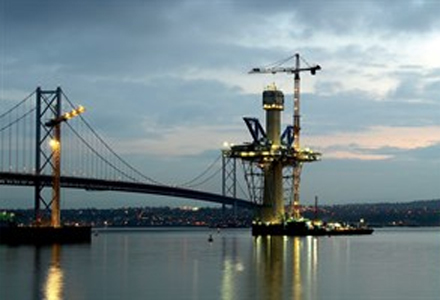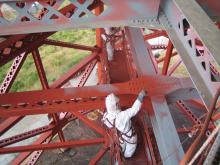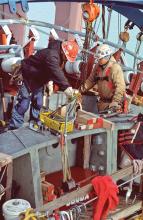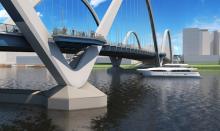
The new Queensferry Crossing under construction in Scotland will be the third landmark bridge spanning the Forth Estuary - Mike Woof writes
When the new Queensferry Crossing over the Forth Estuary opens at the end of 2016, it will be the third landmark bridge to be built spanning this short stretch of water. Lying alongside the existing road bridge and the historic rail bridge, this new structure will be as groundbreaking as the two earlier crossings were at the time of their construction.
The Queensferry Crossing is the centrepiece of the upgrade to Scotland’s key cross-Forth transport corridor. The 2.7km structure is highly innovative from an engineering perspective and will be the longest three-tower, cable-stayed bridge in the world when complete. It will also be the largest cable-stayed bridge to feature cables that cross mid-span. This novel design feature has been used as it boosts the strength and stiffness of the structure overall, allowing the bridge to feature more slender towers and a much lighter deck.
In addition to the new bridge are a series of new junctions and motorway links being constructed on either side of the Forth Estuary. Some of these road sections are already complete: the M9 Junction 1a opened in February 2013.
The need for the new Queensferry Crossing has been apparent for some time. The existing Forth Road Bridge was a pioneering structure when it was designed in the 1950s, leading the way with regard to the design of suspension bridges. At 2.5km long, it was one of the longest suspension bridges in the world when it opened and featured many design innovations.
But the existing bridge has capacity issues as its designers had no idea the vehicle population would grow to such an extent.
The bridge was designed and built to a tighter brief than could have been achieved in previous decades and when it opened in September 1964 it carried around 4 million vehicles/year and was designed with a capacity of 11 million vehicles/year. At present it is carrying 24 million vehicles/year and even that figure does not quite reveal the increase in load that the structure of the Forth Road suspension bridge has to cope with every day. The weight of the average family car has doubled since the bridge was opened while the weight of an HGV has tripled. Worse still, the percentage of HGV traffic has increased from when the bridge was designed, as more goods are now transported by road than by rail.
The growth in traffic saw plans being drawn up for a new crossing in the early 1990s. These were shelved in 1997 but around 10 years ago investigations into the condition of the 600mm diameter steel cables supporting the existing Forth Road Bridge showed that they were suffering corrosion. Although the cables were galvanised, they had been strung in the open air during construction and with no measures to remove any moisture. Given that the Forth Estuary is tidal, the salt water has added an additional corrosive factor.Monitoring of the cables using noise detection technology showed that a few strands had indeed broken (only 1% of the strands have failed). An innovative system for dehumidification of the cables was then developed and installed and this has since prevented any further corrosion, addressing the problem.
This issue meant that the plan to construct a new crossing was revived. A tunnel was considered but was ruled out largely on the grounds of cost as it would have been around twice the price to construct as a bridge link.
Once the official go-ahead was given for the new bridge, the tender process commenced, followed by the award of the contract. The principal contract for the Queensferry Crossing included the bridge itself as well as the connecting roads.
The new bridge has benefited from huge advances in design and will be easier to maintain than the old road bridge, as well as being much stiffer. High winds are a problem in the Forth Estuary and poor weather does result in the existing bridge being closed to high-sided vehicles and motorcycles, or closed completely on occasion. The new bridge however has 3.6m-high sides and offers much greater protection for vehicles crossing, so it should only be closed to traffic when wind speeds top 184km/h.
The new Queensferry Crossing will feature two traffic lanes in either direction, as well as having a hard shoulder all the way across. This allows it to be classified as having motorway status, unlike the existing bridge which has no hard shoulder and can suffer heavy delays from vehicles breaking down.
Mike Martin is project director for the Queensferry Crossing and said, “Unlike a lot of projects, we’re very much under budget.”
Estimates for the Queensferry Crossing suggested that it would cost around £1.6 billion to construct. However, the project has been highly successful in lowering costs with the final price tag now looking likely to fall within the £1.38-£1.45 billion range. Martin said, “We were able to release funds back to the Scottish Government.”
The project has not been without its challenges and the area is known for suffering high winds in bad weather, as well as difficult tides. From a technical standpoint the difficult geology under the Firth of Forth proved troublesome for the construction of the bridge piers. One of the bridge piers on the southern side of the new bridge was a cause for concern initially. Investigations showed that the rock was weak but after boring deeper the team located rock with a suitable bearing capacity.
The towers have been constructed using 1,200tonne steel caissons with a diameter of 30m as a base. These were fixed onto the bedrock and the concrete was poured in to a height of 26m. The towers measure 14m x 16m at the base, tapering gracefully to 4.5m x 7.5m. The
In all, the bridge project has used 500,000tonnes of high-quality concrete, produced from a batching plant located in the worksite at Rosyth. Martin said, “We’ve poured the towers from the estuary with pumps on the barges.”
The concrete has been pumped at a pressure of 200bar to ensure it reaches the height necessary and these pours have been carried out in 4m lifts with 54 pours/tower. And in addition to the innovative design, the project has also seen a number of others engineering records being set. The South Tower has set a record for the world’s biggest ever continuous concrete pour. In all 16,869m3 of concrete was pumped to form the base of the tower.
The steelwork for the bridge deck has been manufactured in China, which did cause negative comments at the time. However Transport Scotland has been at pains to point out that the steel supply deal was won in an open tender and that the Chinese firm offered the best price for the high-quality structures required. This has been in a factor in lowering the cost of building the bridge. Transport Scotland has also pointed out that of the 483 sub-contractors working on the project, 265 are local firms while Scottish companies have provided 23,754 of the 26,122 supply orders for the project overall.
The steel deck sections were transported from China on a special vessel, which had to be unloaded quickly and efficiently as cost penalties would have been substantial had the ship been delayed. Once unloaded, the deck sections were moved using a mobile transporter and have been prepared inside the old Royal Navy sheds at Rosyth. The area where the deck sections are being stored prior to being installed is reclaimed land, a dumping area for spoil from when the historic Royal Navy dockyard was first excavated in 1909. However the ground is very soft and to cope with the weight of the deck sections, the area had to be piled to a depth of 12m. Without this, the heavy steel sections would have sunk into the ground.
A kingpost and cable system mounted on the towers is being used to raise the deck sections from the barges using the balanced cantilever erection method. There is a degree of flex in the tower as these are raised to full height but this has been anticipated and the structure is easily able to cope with the load.
The cable-stayed design will be easier to maintain and will allow entire cables to be taken out for maintenance if necessary, without adversely affecting the traffic capacity.
The cables are anchored at the top and bottom and are sheathed to provide protection against corrosion while this novel plastic sheathing features a ribbed design, which is intended to eliminate any resonance in the wind.
Low noise surfacing is used for the motorway on either side of the bridge as well as running across the structure. The bridge decks are paved with 125mm-thick asphalt comprising an 85mm base and a 40mm wearing course, which itself lies on top of reinforced concrete poured onto the steel deck.
Because the only expansion joints are at the north and south ends of the structure, this will allow a smoother ride for drivers while the surface is also expected to last considerably longer than that on the existing Forth Road Bridge.
The improved link roads form an important part of the new crossing. To the south of the bridge the new motorway runs in a cutting up to 9m deep. A new bund has also been constructed to shield the town of South Queensferry from the traffic noise and this is topped with noise attenuation barriers to further reduce disturbance.
With the opening of the new Queensferry Crossing in late 2016, the existing Forth Road Bridge will be able to go into a graceful semi-retirement that will allow the structure to last for many decades to come. Without the daily pounding from HGVs, its lifespan will be extended considerably and instead it will carry only buses, taxis, motorcycles with capacities of less than 125cc, cyclists and pedestrians. There are suggestions that it could also carry a tram line should the link from Edinburgh Airport be extended northwards in the direction of Fife.
Engineering advances
The advances in engineering technology during WWII meant that the Forth Road Bridge was designed far more precisely to a specific factor of safety than earlier suspension bridges, such as the Golden Gate in California.
Built in the 1930s, the Golden Gate was massively over-engineered by modern standards, which is why it has coped so well with the huge increases in vehicle traffic and structural loads it now carries. In this respect, the existing Forth Road Bridge has been a victim of the more sophisticated engineering used in its design and construction, as well as the totally unforeseen explosion in vehicle numbers. It is worth noting too that the existing Forth Road Bridge, which was well designed and built and has also been well maintained, is by no means alone in having to cope with a huge increase in vehicle numbers. Many bridges constructed in the 1950s, 1960s and 1970s in North America and Europe are suffering similar issues.









